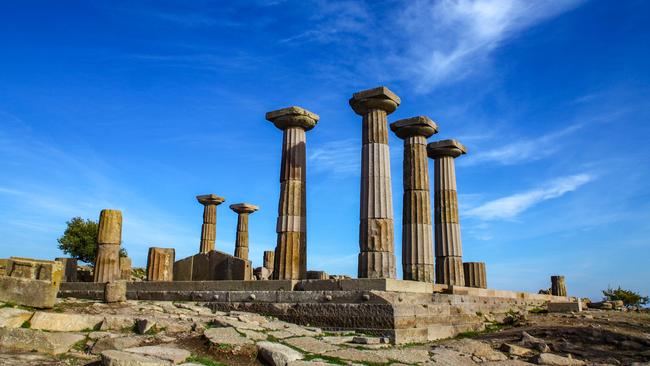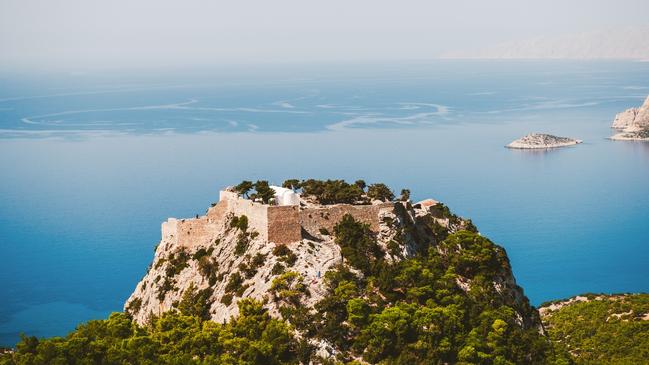Rhodes, a Greek island with a wealth of castles, history and beaches
The Greek island presents a richly woven tapestry of castles, legends and history draped around azure bays.

To my right, a vertiginous drop to a dry moat that curves away around massive fortifications. Below to my left, a labyrinth of tiny streets, buttressed alleys little wider than a laden scooter, with domes and towers topped with sickles and crosses.
I am standing high on the mighty walls of the ancient Old Town of Rhodes. First fortified at the end of the 5th century BC, its remains mostly date from the medieval Knights Hospitaller (later the Knights of Malta) who ruled here for more than two centuries after leaving Cyprus in 1307. This citadel city is at the heart of a ring of dramatic cliff-top defences circling the island, aimed at keeping out the Knights’ arch-enemies, the Ottoman Turks, who finally laid a successful siege five centuries ago this year.
The atmospheric ruins of these lofty fortifications still dot the coast, punctuated by dashes of glorious beach far below. We plot a coastal castle crawl, circumnavigating the island through these dots and dashes. But first, we explore the mothership.
In 1522, Suleiman the Magnificent, the newly enthroned Ottoman Sultan, arrived on the island with a colourful fleet of some 400 ships and 100,000 men, far outnumbering the Knights. It took six months, but in the end Rhodes Town’s churches became mosques, Islamic fountains bloomed in squares, and painted wooden balconies adorned facades.
Beneath it all, however, the Knights’ citadel city survived, and still does, due largely to restoration and renovation by the Italians, keen to claim Christian legitimacy after ousting the Ottomans in 1912.

Wandering through the Old Town, we visit the religious and administrative buildings of these warrior monks, the fortress-like palace of their Grand Master, and their plain-faced communal homes (auberges) on the cobbled Street of the Knights. At the former Auberge of Auvergne, now a wine bar/cafe, we grab a lunch of traditional fava bean paste and crispy Rhodian pitta, before entering the Knights’ arcaded 15th-century hospital. Now the archaeological museum, it houses a remarkable collection spanning Mycenaean to Ottoman: sublime classical statuary to eccentric 2500-year-old human-faced pots.
Emerging through Marine Gate, at the centre of a curve of castellated fortifications, I’m met with a sparkling view of Rhodes harbour. The island was central to Mediterranean maritime activity from ancient times, and seaborne arrivals were once welcomed by one of the Seven Wonders of the World, the towering 32m bronze statue of patron-god Helios, the Colossus of Rhodes.
The Knights’ Fort of St Nicholas at the harbour entrance seems prosaic by comparison, but the Colossus lasted less than a century; the fort has stood for more than half a millennium. The Knights built sturdily, and extensively.
We set out on our coastal tour, beginning just half an hour from the city at the long golden sands of Tsambika beach. Almost alone on this warm October morning, we float in the clear water, admiring the distant white of the eponymous hilltop monastery. Though we know it sits atop the next cliff, we can’t yet see our first castle, and the village beneath it stays hidden until we are right upon it, folded into the rocky terrain, safely out of sight of invaders and pirates. A stepped path leads up over “ceramic slopes”, the source of light clay still used to make sought-after local pottery, past herds of bleating goats, to Archangelos Castle. A ruined triangle of 15th-century fortification, it is an idyllic spot, home to a small modern chapel, scampering agama lizards and a delightful flutter of swallowtail butterflies, as well as panoramic sea views.
Having extracted our car from a maze of narrow streets, we stop again just 5km further on. Beyond two dark caverns used as hideouts in the Second World War, a rough, rocky stairway leads to Faraklou Castle, high on the headland. As we pick our way along the narrow stone walkway just inside the cliff-edge crenellations, we find fragments of wall dating back to the site’s original Byzantine castle, the first fortress to fall to the Knights when they arrived here. The Hospitallers, who were expelled from Jerusalem after the Muslim takeover, wanted a home of their own and plumped for Rhodes – even if they had to take it by force and continually defend it.

With its store rooms and water cisterns, Faraklou was a siege-ready citadel large enough to accommodate the whole local population, as well as protecting the two picturesque bays that twinkle far below. We quickly identify our next beach stop: Agathi Bay, with fine yellow sand sloping into azure sea, and a single thatched taverna awaiting our lunchtime order.
The first view of Lindos, when we resume our journey, is spectacular. Carved into the hillside of a steep almost-island surrounded by little bays (one of which is said to have hosted St Paul), it is dominated by the acropolis towering above.
The Ottoman-inspired boutique hotel, Melenos, is our base. We wake just beneath the castle-acropolis. The pride of the complex, rising from its peak, is the high-columned Temple of Athena, a target for tourists for millennia. “The base of the walls is 9th or 8th century BC,” says our guide. “The ancients kept the walls low to show off one of the artistically richest acropolises in the ancient world. But the Knights built them up for defence and the Ottomans garrisoned troops here until the mid-19th-century.”
A paddle in emerald water rippling over a sun-streaked seabed, and a sandy-toed lunch of dips and fresh Greek salad sets us up to move on. Passing the Knights’ Asklipio Castle, with sightlines to Faraklou, we reach the island’s southernmost cape. Here, at low tide, a double beach emerges, stretching like the neck of a Greek vase across to Prassonissi (meaning “green island”). We are tempted to swim again, but instead take a walk up a hill chequered with sandy-coloured remains of a 6th-century BC settlement.

The west coast brings landscapes of a different kind. Striking, striation-striped mountains rise above broad green plains as we head towards Monolithos Castle. The most dramatically perched of all the Knights’ defences, it sits on the sheer-sided 100m high monolith – no surprise that it was never conquered. Today the ruins are nothing if not Instagrammable. A gaggle of rugged Aleppo pines (oozing rich-smelling resin) gather around a little white chapel to St Panteleimon. Inland, every detail of the mountains glows. A hearty supper of vegetables and rustic village pasta and a comfortable bed at Limeri Guesthouse bring us to the final day of our castle crawl. Kritinia stands 250m above the Aegean, one topless tower protruding precariously over the sea. The Knights built it in time to help repel the 160-ship Ottoman invasion that arrived here in 1480, an event that proved to be a bloody dress rehearsal for 1522.
We stop at the archaeological site of ancient Kamiros, where extensive remains of an ancient Greek city stretch amphitheatre-style up the hillside, and swim at the beach just beneath it, before continuing up the coast to Ialysos. There was once a Knights’ castle here, high above the modern town, but today we find peacocks pecking at Hellenic column tops in front of a 15th-century monastery. This housed the Knights’ most revered icon, the Virgin of Filerimos, believed to have intervened on their behalf in the 1480 invasion.
Where was she in 1522, we wonder, as we come full circle, back towards Rhodes Town, the Knights’ powerfully encircled HQ. “The physical fortifications never actually failed,” our guide tells us. “The hole in the defences was human.” Despite their evident strength and dominant positions, 500 years ago, all these awe-inspiring constructions counted for naught. They do, though, provide the perfect excuse these days for a supremely scenic, beach-embellished castle crawl.
Juliet Rix was a guest of British travel agent Sunvil and the Greek National Tourism Organisation.
THE TIMES




To join the conversation, please log in. Don't have an account? Register
Join the conversation, you are commenting as Logout